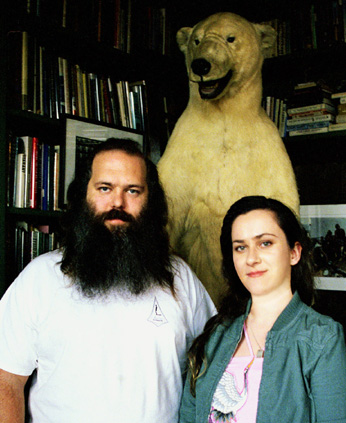 The author, right, with Rick Rubin at his Los Angeles home in October of 2003. The author, right, with Rick Rubin at his Los Angeles home in October of 2003. |
Born in 1975 in Moscow, Russia, Stacy Gueraseva moved with her parents and twin sister to New York City in 1981 when her father was assigned to a post with the United Nations. Growing up during the Cold War in the Bronx as a Soviet citizen, Stacy always viewed her surroundings through a unique cultural lens. She was exposed to a mix of many cultures-from Latino to Eastern European, to Asian-as well as to the music of hip hop, which originated in the Bronx and was ever-present on its streets.
Stacy and her twin sister were the first Soviet kids (non-immigrant Russians) to be accepted into an American high school. The news landed them in the pages of the New York Times.
Although she grew up in a Russian-speaking household and community, Stacy mastered the English language by the time she started at Smith College in 1993, which she graduated four years later with a Bachelor of Arts degree in American Studies.
At 24, she became the editor-in-chief of Russell Simmons' Oneworld magazine, after stints at ELLE magazine and Atlantic Records. At Oneworld, Stacy conceived and edited breakthrough stories on subjects ranging from Black-Jewish relations in New York to recording engineers. Covers subjects have included such personalities as Erykah Badu, Tyra Banks, D'Angelo and Aaliyah. Stacy's writing has appeared in magazines like Vibe, Interview, XXL and Fader. Stacy has travelled extensively to countries like Spain, Italy, France, the UK, Austria, Israel, Belgium, the Netherlands, Germany, Hungary, Denmark, Mexico, Croatia and Serbia. She lives in Brooklyn. |
A CONVERSATION WITH THE AUTHOR...
Q: What compelled you to write this story?
A: Stories of triumph have always fascinated me, and Def Jam has a great one.
Def Jam consistently pumped out platinum and gold-selling albums at a time
when hip hop was still considered a marginal music. Add to that money,
egos, sex, drugs and the downtown New York club scene, and it become a
really juicy story. It's just filled with so many colorful and famous
personalities: The Beastie Boys, LL Cool J, Public Enemy, Jay, and all of
their stories intertwine to create this one great American tale. I knew I
had to write it, finally and definitevely.
Q: Based on your research and interviews, why do you think Def Jam, a small label with a young and somewhat
inexperienced staff, became such a powerhouse?
A: Def Jam survived and thrived through the years, because of a combination of great leadership, hit records, a
dedicated staff, cutting edge marketing and promotion, and sheer luck. Artists like the Beastie Boys and LL Cool
J-the ones responsible for Def Jam's early success-were undeniable stars, brimming with charisma and talent.
They would have become successful wherever they ended up, but at Def Jam, they became superstars. That's
because everyone at Def Jam was consumed with pushing the label. It was a one-for-all and all-for-one mentality
that was unprecedented. What also helped the label reach its full potential was a very powerful parent company,
CBS Records, that provided the best distribution in the world.
Q: Why is the story behind the music just as important as is the music itself?
A: The music itself is only half of a success story -whether we're talking about an artist or a record label. Anyone
who has ever listened to a record and wondered what it took to get that record into stores and into consumers'
hands, will relish knowing more about the music-making process. In the case of Def Jam, what went on
behind-the-scenes to get the music made, is truly fascinating. The story behind the music helps us get to know
the personalities who shaped the music, and that makes for a three-dimensional portrait of the company.
Q: What is it about Russell Simmons and Rick Rubin that made them able to do
what no one had done before-make Hip-Hop music a crossover success?
A: Rick and Russell were incredibly passionate believers. Their personalities
were undeniable: they were forward-thinking, fierce, they knew what they
wanted and how to get it. They were never shy about their demands, and
always demanded what they thought they deserved. As partners, they
complemented one another: Rick was a visionary when it came to the music,
making sure that Def Jam's early records sounded like nothing else in hip
hop; Russell was the consummate networker, always coming up with new
avenues to promote Def Jam artists. Very early on, Russell had decided
that hip hop can become a commercially successful genre; like some kind of
prophet, he saw the music's potential. And he followed that vision, with
complete and total determination.
Q: Why do you think the Hip Hop movement exploded when it did?
A: The Hip Hop movement has experienced several explosions. You could say
that when Run-DMC became the first rap stars to get a major endorsement
deal-with Adidas in 1986-hip hop had exploded. But that feat wouldn't have
happened had Run-DMC not recorded "Walk This Way" with Aerosmith, which
was a collaboration that Rick Rubin masterminded. That song and video put
hip hop directly into middle America's living rooms. It opened the door
for other acts, including the Beastie Boys. Very quickly, hip hop found
its market-millions of teenagers across America, eager to rebel-records
started selling, tours started selling out, it started becoming
legitimized as a profitable genre. It was very simple: Young kids were
ready for the fresh, cutting-edge sounds of hip hop, at a time when music
was very heavy on pop and adult contemporary. Beyond just the music, hip
hop offered young kids a culture they could call their own, and
encompassed graffiti, breakdancing, fashion and Djing. It was as though
the market demanded this kind of in-your-face attitude of hip hop. It
wouldn't be long before a hip hop artist would be winning the Grammy for
Album of the Year-Lauryn Hill for Miseducation of Lauryn Hill in
1999-which was a global explosion, like nothing before. She, in turn,
opened the door for huge rap artists like Eminem and 50 Cent.
Q: What impact do you think Def Jam still has on today's young artists and
producers and on the music industry as a whole?
A: Just the fact that Def Jam has been around for 20 years is teaching the
industry a huge lesson about longevity, which can be very elusive. Def Jam
has been able to evolve and change with the times. The reason that so many
hip hop labels have failed-despite strong entries onto the scene-was
because they didn't know how to change with the times and the changing
tastes of their audience. Def Jam has managed to keep up, but not just to
keep up but to lead. It's a company that has always done something
surprising, unexpected. A perfect recent example is the appointment of
Jay-Z as the head of Def Jam. He is perhaps the first rapper in the
history of music to be given such a title. Only at Def Jam, which has
always made sure that it stays connected, deeply connected to the  streets,
where hip hop has originated. Jay-Z's presidency shows aspiring rappers,
producers that you can not only become a hugely successful rapper, if you
put your mind to it, but also a big-shot executive, a businessman. That's
the type of example that Def Jam sets: that you can succeed by being
yourself.
It also constantly shows the marketplace how a brand can continue evolving
and becoming stronger, through the use of other media outlets. Def Jam was
the first hip hop label to spin-off a video game, using the Def Jam logo
and its artists: Def Jam Vendetta. Over the years, Def Jam has expanded
into television with "Def Comedy Jam," technology with Def Jam Mobile. Def
Jam constantly thinks of new and creative ways to push the brand, to keep
it fresh and in the public eye. Even when, back in the early ‘90s, Def Jam
was having a slow period in terms of record sales, it stayed hot with the
very successful show, "Def Comedy Jam." As for the music, Def Jam's catalog is so remarkable, that it will forever
serve as the standard for excellence in hip hop. streets,
where hip hop has originated. Jay-Z's presidency shows aspiring rappers,
producers that you can not only become a hugely successful rapper, if you
put your mind to it, but also a big-shot executive, a businessman. That's
the type of example that Def Jam sets: that you can succeed by being
yourself.
It also constantly shows the marketplace how a brand can continue evolving
and becoming stronger, through the use of other media outlets. Def Jam was
the first hip hop label to spin-off a video game, using the Def Jam logo
and its artists: Def Jam Vendetta. Over the years, Def Jam has expanded
into television with "Def Comedy Jam," technology with Def Jam Mobile. Def
Jam constantly thinks of new and creative ways to push the brand, to keep
it fresh and in the public eye. Even when, back in the early ‘90s, Def Jam
was having a slow period in terms of record sales, it stayed hot with the
very successful show, "Def Comedy Jam." As for the music, Def Jam's catalog is so remarkable, that it will forever
serve as the standard for excellence in hip hop. |